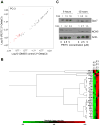Differential response of normal (PrEC) and cancerous human prostate cells (PC-3) to phenethyl isothiocyanate-mediated changes in expression of antioxidant defense genes
- PMID: 20872049
- PMCID: PMC2987529
- DOI: 10.1007/s11095-010-0278-4
Differential response of normal (PrEC) and cancerous human prostate cells (PC-3) to phenethyl isothiocyanate-mediated changes in expression of antioxidant defense genes
Abstract
Purpose: The present study was undertaken to test a hypothesis that differential sensitivity of normal and cancerous human prostate cells to prooxidant effect of phenethyl isothiocyanate (PEITC) is determined by altered expression of antioxidant defense genes.
Methods: Prooxidant effect of PEITC was assessed by flow cytometry using a chemical probe and measurement of hydrogen peroxide production. Gene expression was determined by real-time PCR using Human Oxidative Stress and Antioxidant Defense RT(2) Profiler™. Protein expression was determined by Western blotting.
Results: The PEITC treatment resulted in generation of reactive oxygen species and hydrogen peroxide production in PC-3 human prostate cancer cells but not in a representative normal human prostate epithelial cell line (PrEC). Basal oxidative stress-antioxidant defense gene expression signature was strikingly different between PC-3 and PrEC cells. The PEITC treatment (2.5 μM, 6 h) caused up-regulation of 29 genes and down-regulation of 2 genes in PC-3 cells. Conversely, 4 genes were up-regulated, and 10 genes were down-regulated by a similar PEITC treatment in the PrEC cell line.
Conclusions: Differential sensitivity of PC-3 versus PrEC cells to prooxidant effect of PEITC is likely attributable to difference in basal as well as altered expression of antioxidant defense genes.
Figures




References
-
- Verhoeven DT, Goldbohm RA, van Poppel G, Verhagen H, van den Brandt PA. Epidemiological studies on brassica vegetables and cancer risk. Cancer Epidemiol Biomarkers Prev. 1996;5:733–48. - PubMed
-
- Ambrosone CB, McCann SE, Freudenheim JL, Marshall JR, Zhang Y, Shields PG. Breast cancer risk in premenopausal women is inversely associated with consumption of broccoli, a source of isothiocyanates, but is not modified by GST genotype. J Nutr. 2004;134:1134–8. - PubMed
-
- Kolonel LN, Hankin JH, Whittemore AS, et al. Vegetables, fruits, legumes and prostate cancer: a multiethnic case-control study. Cancer Epidemiol Biomarkers Prev. 2000;9:795–804. - PubMed
-
- Jemal A, Siegel R, Ward E, Hao Y, Xu J, Thun MJ. Cancer statistics 2009. CA Cancer J Clin. 2009;59:225–249. - PubMed
-
- Fahey JW, Zalcmann AT, Talalay P. The chemical diversity and distribution of glucosinolates and isothiocyanates among plants. Phytochem. 2001;56:5–51. - PubMed
Publication types
MeSH terms
Substances
Grants and funding
LinkOut - more resources
Full Text Sources
Medical

